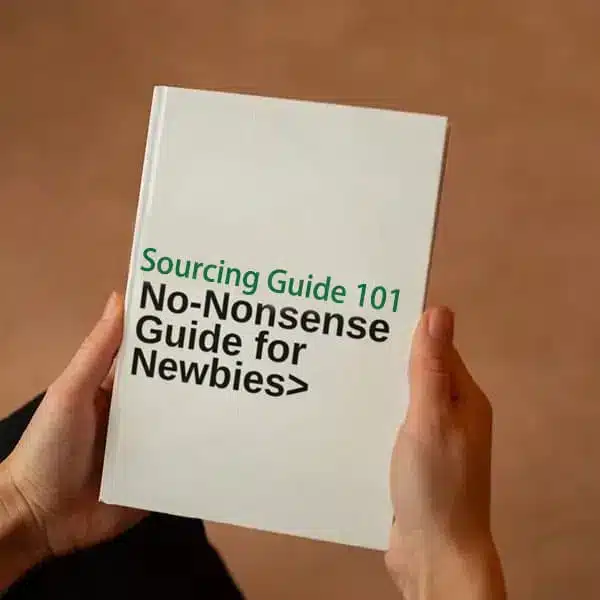Introduction – Decision Time
Okay. You’ve done the hard work: found potential suppliers, checked their backgrounds (Chapter 6), and gotten clear quotes1 (Chapter 7). Now you probably have a small list of maybe 2-4 suppliers who all look pretty good on paper. So, how do you choose THE ONE to trust with your order and your money2?
It’s tempting to just pick the cheapest one, but hold on. There’s a bit more to consider to make sure you’re setting yourself up for success. Choosing the right partner goes beyond just the price tag.

Let’s walk through 5 crucial checkpoints to compare your final contenders. This will help you weigh the pros and cons and confidently choose the supplier that’s the best overall fit for your specific needs.
Checkpoint 1 – That Super Low Price: What’s the Catch?
We all love a bargain, right? But when comparing supplier quotes, if one price seems way lower than the others, put on your detective hat for a second. Price is important, but it shouldn’t be the only factor. Sometimes, a super low price comes with hidden reasons:

-
Lower Quality Materials: Maybe they’re using a thinner fabric, a cheaper grade of plastic, or less durable components than the other suppliers to cut costs. You often can’t tell this just from pictures.
- Example: You get quotes for plain white t-shirts. Supplier A is $2, Supplier B is $4. Why the difference? Supplier A might be using thin, see-through fabric that loses shape after one wash, while Supplier B uses thicker, softer cotton with better stitching. The $2 shirt might disappoint your customers.
-
Smaller Size or Weight: The product might look the same in photos, but it could be slightly smaller or lighter than what others quoted, using less material overall.
-
Overstock Price (Like We Mentioned.): It might be a one-time low price for old inventory (remember Chapter 7?). Your next order will likely cost much more, and the quality might not be guaranteed.
-
Cutting Corners3: They might be skipping important quality checks or using less skilled labor to hit that low price point.
The Golden Rule: You often get what you pay for.4 While factories in China are efficient, really significant price differences between seemingly similar quotes usually mean there’s an underlying difference in quality, materials, or process. Don’t just jump at the lowest number – try to understand why it’s lower and if you’re willing to accept the potential trade-offs. Sometimes, paying 10-20% more for a reliable supplier known for consistent quality is a much smarter long-term investment.
Checkpoint 2 – Get Samples. Feel the Quality Yourself
This is probably the single most important step before placing a real order, especially your first one with a supplier. Pictures can be deceiving, descriptions can be vague, but holding a physical sample in your hands tells you almost everything you need to know about the actual production quality.

-
Why Samples Are Non-Negotiable:
-
Verify Quality5: Is the stitching neat? Is the material what you expected? Does it work correctly? Is the color right?
-
Test Durability: You can actually use it, wash it, test it to see how it holds up.
-
Check Fit & Finish: See how parts fit together, feel the texture, check the overall look and feel.
-
Peace of Mind: It confirms the supplier can actually make the product to your standards before you commit thousands of dollars.
-
-
The Cost of Samples6: Yes, samples cost money, but think of it as cheap insurance.
- Sample Fee: Suppliers usually charge for the sample itself (often more than the bulk price because it’s a small run).
- Shipping Cost: International express shipping (like DHL, FedEx) for samples isn’t cheap. Expect to pay $30-$100+ per supplier just for shipping, depending on the size/weight and destination.
- Budgeting: If you’re sampling one product from 3-4 suppliers, easily budget $100-$300+ just for getting those samples delivered. Yes, it adds up, but it’s far less costly than receiving a whole container load of poor-quality goods.
- Example (Custom Phone Grips): You want custom-designed phone grips. The bulk price is $1.50. Each supplier might charge $10-$20 for the sample itself, plus $40-$50 for express shipping. Getting samples from 3 suppliers could cost around $150-$210. Worth it.
-
Samples for New vs. Existing Products:
-
Existing Products (or simple tweaks): Getting samples is usually straightforward and relatively quick.
-
Brand New Products (requiring molds/tooling): This is more complex and expensive. Creating a custom mold (like for a unique plastic shape) can cost thousands of dollars upfront (see Chapter 1, Section 4). Suppliers won’t usually make a mold just for a free sample. You’ll likely need to commit to the mold cost first, then get pre-production samples made from that mold before starting mass production. This requires careful planning and a bigger budget.
-
-
Agent Advantage7: Getting samples from multiple suppliers shipped individually gets expensive fast. A sourcing agent (like Green Sourcing.) can often collect samples from all your potential suppliers at our office in China, do an initial check for you, and then ship them all together to you in one box. This saves you a LOT on international shipping fees.
Bottom Line: Don’t skip samples. Budget for them. They are your best tool for judging real quality before you commit to a large order.
Checkpoint 3 – Good Communication Saves You Time, Energy & Money
Think about any relationship – business or personal. Does good communication8 make things easier? Absolutely. Dealing with suppliers is no different. How well a supplier communicates during the quoting and sampling process9 is often a strong indicator of how they’ll communicate after you place an order (when problems might arise).

-
What Makes Communication "Good"?
-
Responsiveness: Do they reply to your emails or messages reasonably quickly (within 1-2 business days, considering time zones)? Or do you have to chase them constantly?
-
Clarity: Do they understand your questions and requests accurately? Do they provide clear, detailed answers? Or are their replies vague, confusing, or ignore parts of your question?
-
Proactiveness & Professionalism: Do they just answer the bare minimum, or do they offer helpful suggestions? Do they anticipate potential issues? Do they admit if they can’t do something, rather than just saying yes to everything?
-
English Proficiency: While perfect English isn’t always necessary, can they understand your technical requirements and express themselves clearly enough to avoid misunderstandings?
-
-
Why It’s So Important:
-
Prevents Errors: Clear communication ensures everyone is on the same page about product specs, packaging, shipping marks, etc., reducing the risk of costly mistakes.
-
Saves Time: You spend less time chasing answers or correcting misunderstandings.
-
Problem Solving: If issues come up during production (and they sometimes do.), a supplier with good communication is much easier to work with to find a solution. Bad communicators might just disappear or become defensive.
-
Indicates Professionalism: Suppliers who invest in good communication often run a more organized and reliable operation overall.
-
-
Red Flags (Bad Communication Examples):
-
Taking days to reply to simple questions.
-
Ignoring specific questions in your email.
-
Giving vague answers like "Price depends" without asking clarifying questions.
-
Making promises they clearly can’t keep.
-
Constantly needing things repeated or explained multiple times.
-
Your Gut Feeling Matters: Even if the price is good, if communication feels like pulling teeth, be wary. Smooth communication is worth its weight in gold when importing.
Checkpoint 4 – Production Time: How Long Will It Take?
Okay, you need your products. But how long will it actually take the supplier to make them after you place the order? This is called the production lead time10, and it can vary significantly.

-
Why Lead Time Matters:
-
Meeting Deadlines: Do you need stock for a specific holiday season (like Christmas) or a product launch date? You need to factor in production time plus shipping time.
-
Trending Products: If you’re selling something hot and trendy, speed is crucial. A shorter lead time means you can get the product to market while it’s still in high demand. A long lead time could mean missing the wave.
-
Cash Flow: Longer lead times mean your money is tied up for longer before you can start selling the goods.
-
-
What Influences Lead Time?
-
Product Complexity: Simple products are usually faster to make than complex ones requiring multiple steps or assembly.
-
Order Quantity: Making 500 units is faster than making 50,000 units.
-
Customization: Products needing custom molds, special materials, or unique printing take longer than standard items.
-
Factory’s Schedule: How busy are they? Are they already booked up with other orders? (This can change seasonally too – factories get very busy before Chinese New Year, for example).
-
Typical Ranges (Very General.):
-
Simple, existing products: Maybe 15-30 days.
-
Products needing some customization/assembly: Maybe 30-45 days.
-
Products needing new molds or complex processes: Maybe 45-60 days or even longer, after the mold is finished.
-
-
-
Ask Your Suppliers: "What is your estimated production lead time for [X quantity] of this item after order confirmation and deposit payment?"
-
Faster Isn’t Always Better: Be cautious if one supplier promises an unrealistically fast lead time compared to others. They might be cutting corners on quality control or not being truthful about their actual capacity. Ask how they can achieve that speed.
Balance is Key: Compare the lead times quoted. Is one supplier significantly faster or slower? Does their timeframe work for your needs? Consider it alongside price, quality, and communication.
Checkpoint 5 – Shipping Solutions & Costs: The Final Leg
Remember our discussion on trade terms (FOB, EXW, DDP) in Chapter 7? Now it’s time to think about how the shipping part impacts your supplier comparison, especially if you’re comparing quotes with different terms.

-
Focus on Total Landed Cost11: Don’t just compare the EXW or FOB product prices. You need to estimate the total cost to get the goods to your door. This includes:
-
Product Cost (based on EXW or FOB)
-
Local China logistics (if EXW)
-
Export fees (if EXW)
-
International Shipping (Sea or Air Freight)
-
Insurance
-
Import Duties & Taxes in your country
-
Customs Broker fees
-
Local delivery in your country
-
-
Comparing Apples to Apples:
-
If quotes are FOB: You’ll need to get shipping quotes from your own freight forwarder for the international leg and import costs to accurately compare the total cost from each supplier (since the port location might affect shipping price).
-
If comparing FOB vs. DDP12: The DDP price includes shipping and duties. You need to get a separate shipping/duty quote for the FOB option to see which is truly cheaper overall. (Often, arranging your own shipping via FOB is more cost-effective than DDP if you have a good freight forwarder).
-
Supplier’s Shipping Offer13: Some suppliers (especially trading companies) might offer to handle shipping for you even if quoting FOB (they’ll just add the shipping cost). Get quotes both ways – using their offer vs. using your own forwarder – to compare. Suppliers sometimes get good rates, but sometimes they add a significant markup.
-
-
Shipping Options & Destination:
Does the supplier have experience shipping to your country? Can they accommodate your preferred method (e.g., faster air freight vs. cheaper sea freight)? For some less common destinations (parts of Africa, Latin America, Eastern Europe), finding reliable and cost-effective shipping solutions might be harder, so choosing a supplier with proven experience shipping to your region can be an advantage.
The Goal: Make sure you factor in realistic shipping costs when comparing your final suppliers. A slightly cheaper product price from Supplier A could easily be wiped out by higher shipping costs compared to Supplier B. Work with a freight forwarder or ask suppliers for shipping estimates to get a clearer picture of the total investment.
Conclusion
Choosing your supplier is a big step. By looking beyond just the initial price and carefully considering these 5 checkpoints – Price Reality Check, Sample Quality, Communication Style, Production Speed, and Total Shipping Cost – you can make a much more informed decision.
It’s about finding the supplier who offers the best overall value and is the most reliable partner for your business needs. Sometimes it’s not the absolute cheapest, but the one who delivers consistent quality, communicates well, meets deadlines, and makes the whole process smoother. Trust your research, trust your samples, trust your gut feeling about communication, and choose confidently. You’re almost ready to place that order.
-
Learning how to evaluate quotes can help you make informed decisions and choose the best supplier for your needs. ↩
-
Building trust with suppliers is crucial for long-term success and can lead to better deals and reliability. ↩
-
Exploring this topic can reveal the hidden costs of choosing low-priced suppliers and the importance of quality assurance. ↩
-
This principle is crucial for making wise purchasing decisions and ensuring long-term satisfaction with your suppliers. ↩
-
Understanding the importance of verifying quality can help you make informed decisions and avoid costly mistakes when sourcing products. ↩
-
Exploring the costs of samples will help you budget effectively and understand the financial implications of sourcing products. ↩
-
Learning about the benefits of using a sourcing agent can save you money and streamline the process of acquiring samples from multiple suppliers. ↩
-
Exploring the importance of good communication can help you improve your business interactions and avoid costly mistakes. ↩
-
Understanding the quoting and sampling process can enhance your supplier relationships and ensure smoother transactions. ↩
-
Understanding production lead time is crucial for effective supply chain management and meeting market demands. Explore this link for in-depth insights. ↩
-
Understanding Total Landed Cost is crucial for accurate supplier comparisons and budgeting. Explore this resource for detailed insights. ↩
-
Learn the key differences between FOB and DDP to make informed shipping decisions and potentially save costs. ↩
-
Evaluating a supplier’s shipping offer can lead to significant savings. Discover strategies to assess these offers wisely. ↩





